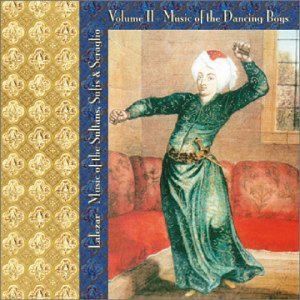The Lalezar Ensemble is part of a current revival of classical Ottoman music under way in Turkey. The group — four instrumentalists and three vocalists — have created four CDs that give a sampling of some of the best and most representative of the five centuries of the Ottoman Empire’s art music. (Volumes III and IV, Minority Composers and Ottoman Suite, are reviewed here.)
Both volumes are fascinating and gorgeously produced. The musicians and singers are top-notch, the music is performed and recorded brilliantly, and the recordings are presented in exemplary packaging. The 40-page booklet accompanying each CD is a mini-course in Turkish music, with excellent artwork, design and writing.
 Sultan Composers is an overview of the Ottoman Empire through the music created by its rulers. Not every Ottoman Sultan from the 15th to the 20th century was a trained musician and composer, but enough of them were to leave this astounding legacy. It’s as if some of the greatest works of Western classical music, from the Renaissance through the Impressionists and into the post-Romantic modernists, had been written by popes, kings, queens, presidents and prime ministers. Imagine if Abraham Lincoln had written piano sonatas like Beethoven, or if Elizabeth I had written plays to rival Shakespeare’s.
Sultan Composers is an overview of the Ottoman Empire through the music created by its rulers. Not every Ottoman Sultan from the 15th to the 20th century was a trained musician and composer, but enough of them were to leave this astounding legacy. It’s as if some of the greatest works of Western classical music, from the Renaissance through the Impressionists and into the post-Romantic modernists, had been written by popes, kings, queens, presidents and prime ministers. Imagine if Abraham Lincoln had written piano sonatas like Beethoven, or if Elizabeth I had written plays to rival Shakespeare’s.
The booklet gives a thumbnail history of the empire, focusing especially on those sultans who were composers, from Bayezid II through Selim III to Abdulaziz and Mahmud II.
Some of the pieces are instrumental, played on Turkish plucked and bowed fiddles and zithers, particularly the tanbur, as well as a reed flute and occasional simple skin drums. Most also feature vocals from the trio of a baritone, a tenor and a soprano.
The texts of the vocal pieces are translated in the booklet, and reflect the changing temperaments and times of the sultans. The lengthy sixth track, a 14-minute suite by Selim III (1789-1808), includes the poetic text that begins, “The burnt wound of love within the firmament of my breast is your star.” By contrast, one of the final tracks, by Abdulaziz (1861-1876), laments “I am restless because of the wailing of the insane bird of my heart.”
 Music of the Dancing Boys is more interesting yet, both for its subject matter and in its actual music. A more accurate title might be “Music for the Dancing Boys,” because this is music associated with the performances of young transvestite dancers, an Ottoman tradition. These highly trained boys performed mimed erotic dances, sometimes solo and sometimes with partners, on all kinds of public occasions. Some of them became stars and entertained at court and for the wealthy, but most performed in the taverns of Istanbul.
Music of the Dancing Boys is more interesting yet, both for its subject matter and in its actual music. A more accurate title might be “Music for the Dancing Boys,” because this is music associated with the performances of young transvestite dancers, an Ottoman tradition. These highly trained boys performed mimed erotic dances, sometimes solo and sometimes with partners, on all kinds of public occasions. Some of them became stars and entertained at court and for the wealthy, but most performed in the taverns of Istanbul.
This CD consists of a suite in a set of related key signatures, all seamlessly connected with barely a pause in a performance of about an hour. It’s somewhat similar in structure to an Indian raga, inasmuch as the piece starts with a semi-improvised instrumental section that establishes the dominant key for the entire suite. The suite contains some instrumental pieces and some solos by male or female voice, but mostly is of all three voices.
This is the only one of the four discs in this set in which the liner notes explicate the work track by track, and it greatly aids in understanding and enjoying the work. Sometimes the transitions between tracks are subtle, sometimes drastic. The mood of the pieces changes frequently, from solemn tunes in four or eight beats, to complex and uptempo numbers in nine, 11 or 16 beats. Individual pieces range from proto-klezmer songs to Balkan folk songs.
If I had to pick a favorite among these four CDs, Music of the Dancing Boys would be it, for its musical variety and its excellent history lesson. As with Volumes III and IV, I can unreservedly recommend Sultan Composers and Music of the Dancing Boys to anyone who likes Middle Eastern, Asian or World music. This is a package of the highest quality.
(Both Traditional Crossroads, 2000)
